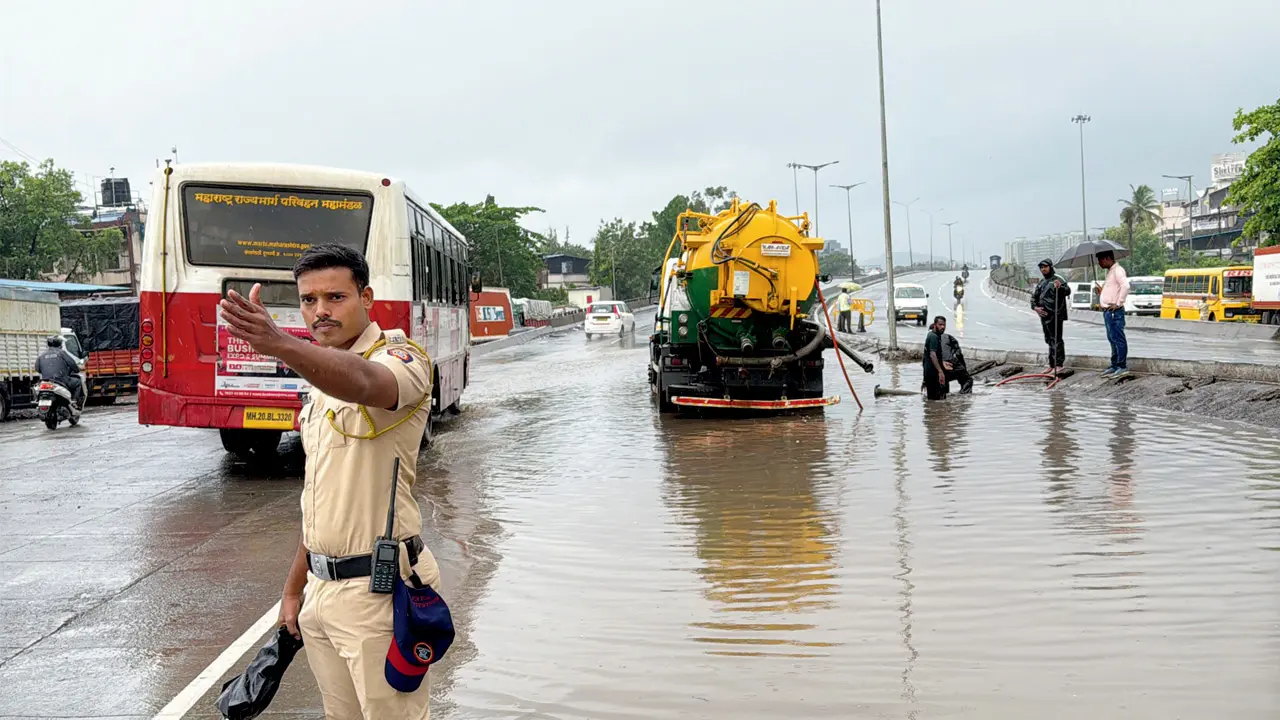Rain reduces freshly concreted Mumbai-Ahmedabad Highway stretch into giant lake
Concerned officials rushed to the site with heavy machinery and tools to clear the stagnant water and restore vehicular movement. Frequent road users said poor drainage planning on the newly laid surface may have contributed to the flooding

A freshly concreted stretch of the Mumbai-Ahmedabad Highway turned into a water trap after the first heavy spell of rain on Monday, raising serious questions about the quality of construction work. The downpour led to severe waterlogging on one side of the highway, disrupting traffic and putting commuters at risk. Visuals from the spot showed vehicles crawling through several inches of accumulated water.
Concerned officials rushed to the site with heavy machinery and tools to clear the stagnant water and restore vehicular movement. Frequent road users said poor drainage planning on the newly laid surface may have contributed to the flooding. AK Sharma, an official at Nirmal Build Infra Private Limited, claimed, “The six-lane stretch is no longer waterlogged.”
mid-day posted an online video and photos from Vasai’s Tungareshwar phata, where the Gujarat-bound stretch was waterlogged, forcing the road users to negotiate the stretch by slowing down their vehicles. A few workers from the local municipal corporation were seen manually creating channels to help the water recede from the highway lane. Additionally, a machine was deployed to expedite the clearance process on the high-speed stretch that connects Maharashtra and Gujarat.
The Mahalaxmi flyover on the NH48. Pics/Hanif Patel
Cops from Mira Bhayandar Vasai Virar police were also seen regulating the traffic at the stretch. “Due to the incomplete work of the NHAI [National Highways Authority of India], water had accumulated on the Mumbai-Ahmedabad Highway. Only after the rainfall did they realise the extent and cause of waterlogging. Coincidentally, around the same time, Chief Minister Devendra Fadnavis travelled via the same highway. Taking serious note of the situation, the NHAI swiftly deployed emergency machinery and managed to bring the waterlogging under control,” said Sushant Patil, a member of a local NGO.
“Water creates a slippery surface, reducing tyre traction. At high speeds — especially on highways — this can lead to skidding or hydroplaning, where vehicles literally float over water instead of gripping the road,” a transporter, Harbans Singh Nanade, told mid-day. “We faced waterlogging at the Mahalaxmi flyover, Navghar and Maljhipada on the NH48 on Monday,” said Nanade.
Harder for drivers
“Above all, splashing water and mist from other vehicles reduces visibility, making it harder for drivers to judge distances or spot hazards in time,” Nanade said.
“Also, drivers may swerve or brake suddenly to avoid flooded patches. On a busy highway, such moves can trigger chain-reaction collisions or rear-end crashes. This is a freshly concreted stretch, but the authorities did not focus on resolving waterlogging. The first heavy spell of rain this monsoon exposed the tall claims of multi-faceted agencies involved in concreting the important stretch between Mumbai and Ahmedabad.”
When contacted, the recently-appointed NHAI Manager, Dipendra Singh Rathore, said, “Almost 80 per cent of white topping work [overlaying an asphalt stretch with a layer of concrete] has been completed. We are working to permanently resolve waterlogging on the stretch.”

 Amritpal Singh Sanhotra
Amritpal Singh Sanhotra 





